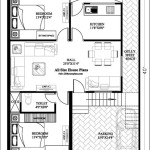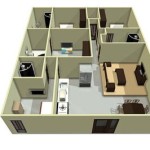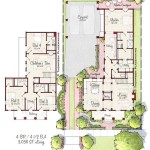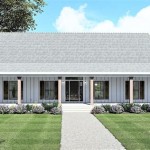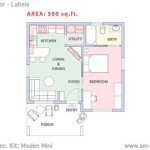Simple House Plan With Dimensions
Finding the perfect house plan involves balancing functionality, aesthetics, and budget. Simple house plans offer an attractive solution for those seeking efficient use of space and cost-effective construction. Understanding the dimensions and layout is crucial in visualizing the final product and ensuring it meets specific needs. This article will explore the concept of simple house plans with dimensions, discussing various aspects to consider when choosing a suitable design.
One of the most popular simple house plan styles is the rectangular or square layout. This design maximizes usable floor space and simplifies construction, leading to potential cost savings. A common example might involve a 20ft x 30ft rectangle, providing 600 square feet of living space. Within this footprint, the layout can be further divided into designated areas for living, dining, kitchen, and bedrooms. Clear dimensions for each room, such as a 10ft x 12ft living room or an 8ft x 10ft bedroom, allow for precise furniture placement and optimized space utilization.
Another popular choice is the L-shaped house plan. This configuration creates a natural division between living spaces and provides opportunities for outdoor areas like patios or courtyards within the "L." For example, a 40ft x 30ft L-shaped plan might dedicate one wing, perhaps 20ft x 30ft, to the main living area, kitchen, and dining room, while the other 10ft projection houses bedrooms and bathrooms. Specific room dimensions within this layout, such as a 15ft x 18ft living area, can further define the space and aid in planning.
Bungalows, often characterized by their single-story layout and compact design, represent another popular simple house plan option. A classic bungalow might feature a 30ft x 40ft footprint encompassing all living spaces on one level. Clear dimensions for each room, like a 12ft x 14ft master bedroom or a 10ft x 10ft kitchen, are vital for maximizing functionality within the limited footprint. Porches, a common feature in bungalows, add to the charm and can be incorporated into the overall dimensions, for instance, a 5ft deep porch along the front of the house.
When evaluating simple house plans with dimensions, carefully consider the needs of the occupants. A young couple may find a smaller, open-plan layout suitable, while a growing family may require dedicated spaces for children, including bedrooms and play areas. The square footage allocated to each function should reflect the intended use and occupancy. For instance, a larger family may prioritize a more spacious kitchen and dining area compared to a smaller household.
Furthermore, local building codes and regulations play a vital role in determining acceptable dimensions and setbacks. These regulations vary depending on the location and must be adhered to during the planning and construction phases. Consulting local authorities or experienced architects ensures compliance and avoids potential complications during the approval process. This includes adhering to minimum room sizes, ceiling heights, and window requirements.
Accessibility is another critical consideration, especially for individuals with mobility challenges. Incorporating wider doorways, ramps instead of stairs, and accessible bathroom layouts ensures inclusivity and comfort for all occupants. Dimensions for hallways and doorways should be carefully considered to accommodate wheelchairs and other mobility aids. Bathrooms should incorporate features like grab bars and roll-in showers, and their dimensions should reflect these requirements.
The orientation of the house on the site is important for maximizing natural light and ventilation. A south-facing orientation allows for passive solar gain during the winter months, while strategically placed windows can promote cross-ventilation, reducing the need for artificial cooling. Analyzing the site's topography and prevailing wind patterns can inform the optimal placement of the house and maximize the benefits of natural elements.
Budget considerations significantly influence the choice of a simple house plan. Smaller footprints typically translate to lower construction costs due to reduced material requirements and labor. Choosing cost-effective materials and finishes further contributes to affordability. However, it’s important to balance cost-saving measures with quality and durability to ensure the long-term value and structural integrity of the house.
Utilizing online resources and architectural software can facilitate the visualization and customization of simple house plans with dimensions. Numerous websites offer pre-designed plans with detailed dimensions that can be adapted to specific needs. These resources allow for exploring various layouts and visualizing the finished product before committing to a particular design. Interactive tools allow for modifying room sizes, adding or removing walls, and experimenting with different configurations.
Consulting with an architect or a building professional is highly recommended, even for simple house plans. They can provide valuable insights, ensure compliance with local regulations, and offer tailored solutions based on individual requirements. They can also assist in navigating the permitting process and oversee the construction phase to ensure the project adheres to the approved plans and specifications. Their expertise can be invaluable in addressing potential challenges and ensuring a successful outcome.

12 Examples Of Floor Plans With Dimensions

Pin On Small House Plans

Simple House Plans Blog Homeplans Com

Floor Plan With Dimensions 1 One House Plans Bungalow Cottage

Floor Plans With Dimensions Including Examples Cedreo

Simple Two Bedroom House Plans With Dimension Cadbull

5 Small And Simple 2 Bedroom House Designs With Floor Plans In 2024 Design Es Two

Simple House Plans Blog Homeplans Com

Stylish And Simple Inexpensive House Plans To Build Houseplans Blog Com

Est House Plans To Build Simple With Style Blog Eplans Com
Related Posts


